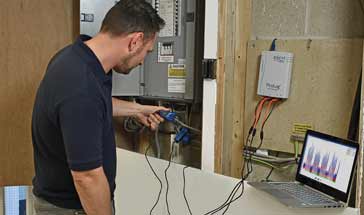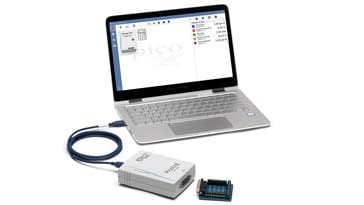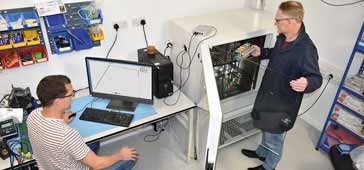Understanding Data Logging & Data Loggers
Data logging is used for monitoring many parameters and physical phenomena, especially over long periods of time
Data Acquisition Includes:
Understanding data acquisition
Data logging systems
DAQ systems
DAQ cards & modules
DAQ measurements
Data acquisition sensors:
Thermocouple temperature sensor
Flow meters
Data loggers are devices that monitor and record data, typically over a long period of time for many applications. Although they are similar to data acquisition systems they rather different and tend to be lower cost and performance.
Normally the measurements have a low sample and data rate and this sets them aside from data acquisition systems which can handle much greater levels of data and rates at which the sensors are measured can be very much higher.

Pico Technology CM3 collecting data
Many data loggers are self contained, and data may be collected periodically as it is often not time sensitive. Data can be collected from time to time and then taken back later for analysis on a larger computer.
From temperature data loggers to USB data loggers, humidity data loggers and many more, there is an enormous variety of equipment available.
Data logger basics
Data loggers may also be called data recorders, and this name gives an insight into their operation and the difference between them and data acquisition systems.
Although simple data loggers of various forms have been in use for many years, increasingly modern data loggers have small processor boards in them to manage the readings that are taken from the sensor or sensors.Generally data loggers are relatively small, and have limited functionality, although with increasing levels of processor control, the levels of functionality are increasing.
However, often data loggers are small and battery powered so that they can be situated in remote locations.
However a good number of data loggers can interface easily with a computer. In fact USB data loggers are widely available on the market. Drawing power over the USB interface and using the computing power of the computer, they are able to provide very sophisticated data logging functions very easily. That said, they are still not as comprehensive in their operation as full data acquisition systems.
Some data loggers are self powered, but have a USB interface to download the data to a computer for processing later. Accordingly there is a good variety of different forms of USB data logger.
Sometimes the data loggers using digital technology in general and signal processing, etc may be called digital data loggers, DDL to differentiate them from some of the older manual or analogue versions.

Data loggers vary from being general purpose designs that can be used in a variety of general purpose applications to others that are designed for a specific application. Often specific sensors and interfaces can be designed to enable them to be used in a niche area.
What is a data logger as opposed to a data acquisition system
There can be a lot of confusion and blurring of the boundaries between data acquisition systems and data loggers. Both types of system sense the environment or some phenomenon and record it in one way or another, but the scale of the system, whether data is just stored for future analysis, whether data is processed and the level of processing can mean that the system is considered to be a data acquisition system or a data logger.
A data logger is a simple form of data acquisition system, but a data acquisition system is not necessarily a data logger.
Some of the differentiators are included below, but in reality for any application, the requirements should be considered and the best option sought whatever name is attached to it.
Sample rate: Data loggers typically have slower sample rates when compared to a data acquisition system. Sample rates of 1Hz may be fast for some data loggers, that may be needed to log data over a period of days, weeks, or even months.
Data stored for later use & analysis: The data in many data loggers is stored and may be downloaded at a later data. Some instruments may have a USB interface that can be plugged into a computer like a memory stick and the data downloaded. Whilst data acquisition systems will store data, they may process it on the fly, and often do much of the processing within the data acquisition system itself.
Self powered: Many data loggers are self powered which enables them to be installed in almost any location without the need for external power. Other data loggers may need external power to be supplied.
Number of sensors: Typically a data logger may have fewer sensors than a full data acquisition system. Some data loggers may only monitor one sensor and record its data. Other may have more, sensing 4, 8, 16 or more points.
Data logging applications
Data loggers can be used in a huge number of applications - in fact anywhere that data needs to be collected and stored or logged.
Although a huge number of measurements can be made, ones like temperature tend to be more widely used and as a result, many temperature data loggers are available.
Although temperature data loggers are one of the most common types, almost any measurement can be applied to a data logger.

It often helps to have an idea where data loggers can be used so that a better understanding of what they are and how they work can be gained. A number of typical applications are detailed below:
Food storage and transport: The food industry needs to transport many foodstuffs under cool or frozen conditions. If they rise above the recommended temperatures they cannot be sold. Accordingly measurement and traceability are key to the industry.
Vaccine storage and transport: This has become very topical with the COVID-19 pandemic where some vaccines need to be stored and transported at very low temperatures. In fact it does not just apply to COVID-19 vaccines, but also many others as well. If they rise above these temperatures they become degraded and cannot be used. Using a data logger can enable readings to be taken and it will give traceable results.
Laboratories: In many laboratories there may be processes that require a specific temperature to be maintained. A data logger can be used to check the temperature, give a record and if necessary raise an alarm if it goes outside the permissible range.
Manufacturing: It is often necessary for specific temperatures to be maintained within a manufacturing plant. Other measurements like flow rates, strain and the like may also be required to ensure that the plant is operating correctly. Specific measurements could also be made with each item manufactured to ensure that the process limits were correct - any later defects could be checked against the manufacturing data, etc . . .
Museums: Museums and galleries need to keep their exhibits under strictly controlled conditions of temperature, humidity and sometimes even light. These parameters can be monitored, logged and if they fall outside the required limits an alarm could be raised.
There are, of course, vast numbers of applications for data loggers. Each has its own requirements and this is why there are many different types available with different sensors, inputs, different levels of processing and computing, and the like.
Data logger basics
It is not possible to totally generalise on data loggers because they can range from very simple manually driven devices right up to sophisticated computer drive or USB data loggers. However there are a few basics that apply to most data loggers.
Top end data loggers tend to be very similar to the lower end data acquisition systems - there is a very broad boundary between the two.
Although some data loggers have only a single sensor and input, many have multiple channels and in many cases they can record measurements from different types of sensor.
Often multichannel data loggers can accept both analogue and digital inputs. Analogue inputs might be used with a specific data logging sensor to make measurements such as temperature, pH, humidity and the like.
To obtain better measurements differential techniques are often used, and this can mean that the number of available analogue inputs is halved.
Digital inputs might include a flow sensor or a wind sensor that gives out a series of digital pulses as the sensor motion detector senses motion. These often have a grating printed one a disc and as this turns a light sining though it onto a photo-sensor is interrupted. In this way a series of pulses, the rate of which is proportional to the speed is produced.
In terms of the circuitry for the data logger, the signal enters from the sensor. Assuming it is in an analogue format, it will pass though signal conditioning to ensure it is in the right format, amplitude, removal of interference, removal of high frequency signals to prevent aliasing in the analogue to digital conversion, etc.
The signal is then applied to an analogue to digital converter, A2D, or ADC to provide the required digital format.
If the signal is already in a digital format, it may still need some signal conditioning to make sure it is in the required format. It can then be applied to the digital circuitry for the relevant processing.
The signal will then be processed in its digital format, typically using some form of microcontroller, or in the case of USB data loggers, this may be undertaken in the computer.
This will enable the data to be time stamped, put into the required format and stored. Other processing may be required if an alarm is to be raised if the signal falls outside specific bounds, etc.
Considerations when buying a data logger
Before buying a data logger, it is worth carefully analysing the requirements, looking at what is really needed, and possibly what might be needed in the future.
It could be very easy to purchase a data acquisition system instead with better performance, but this may not be required, so a careful analysis of what is actually needed should always be undertaken.
The list below is some of the considerations that may be looked as part of the decision process.
Multi-channel or single channel: For many applications a single channel measurement may be all that is needed, whereas for others, multiple channels may be a key requirement.
What type of inputs are required: The type of measurements that need to be made will dictate the inputs required. For multi-channel data loggers, it is often possible to get inputs that can be either analogue or digital, and configured to the type of sensor or sensors being used. Ensure the inputs can cater for the sensors and measurements you need.
Differential capability: Often to gain the best measurements it may be necessary to use differential inputs. Check wether this can be done - depending upon the data logger it is most likely to halve the number of inputs available.
Accuracy: Ensure that the data logger being considered offers the required accuracy. This will depend to soem degree on the number of bits in the analogue to digital conversion, but also on other aspects of the design.
Speed: Many data loggers take measurements relatively slowly. A repetition rate of 1 Hz could be the maximum for some units. Some can operate faster and others more slowly. Ensure that the measurement repetition rate is sufficient for the given application.
Storage / interface: Some units store the data recorded onto a memory card and this can be downloaded later - sometimes a USB interface is used for this. Other ones may be full USB data loggers that have a live USB link to a computer. There are also wireless data loggers as well, but ensure that the wireless link can be made reliable as metal objects in way can easily disrupt the link - wireless is generally not as reliable as a wired connection.
Endurance: Some self powered loggers may need to operate remotely for some time. Check that the unit being considered has sufficient battery capability, etc to last the time required.
Memory capability: With the possibility of large amounts of data being collected, check that there is sufficient memory capacity available for storage.
Real time measurements: Most data loggers will write the measurements to a memory for retrieval at a later time. However some , more sophisticated units have the ability to output or display the measurements as they are taken. This real-tine capability may be important for some situations. Check that this is available if it is important.
Environmental aspect: If the data logger is to be located outside or in another harsh environment, check that it has been designed and built to withstand the envisaged conditions - temperature specification, rain, dust, etc.
Size & weight: The size and weight could be an issue in sme situations. Most loggers are relatively small and can be suitably accommodated, but if this could be an issue, check all the available space and the dimensions of the particular unit.
Data loggers come in all forms, formats and can make many different types of measurement: temperature data loggers, flow measurements, voltage, current . . . and then there are stand alone units, USB data loggers, wireless data loggers . . there is a huge variety to meet every need.
Data loggers typically have slow measurement rates, but even so they are incredibly useful for a hole variety of different applications. With such a huge variety available, competition is fierce and costs can be low, especially when considering what can be bought for a given budget.
 Written by Ian Poole .
Written by Ian Poole .
Experienced electronics engineer and author.
More Test Topics:
Data network analyzer
Digital Multimeter
Frequency counter
Oscilloscope
Signal generators
Spectrum analyzer
LCR meter
Dip meter, GDO
Logic analyzer
RF power meter
RF signal generator
Logic probe
PAT testing & testers
Time domain reflectometer
Vector network analyzer
PXI
GPIB
Boundary scan / JTAG
Data acquisition
Return to Test menu . . .



